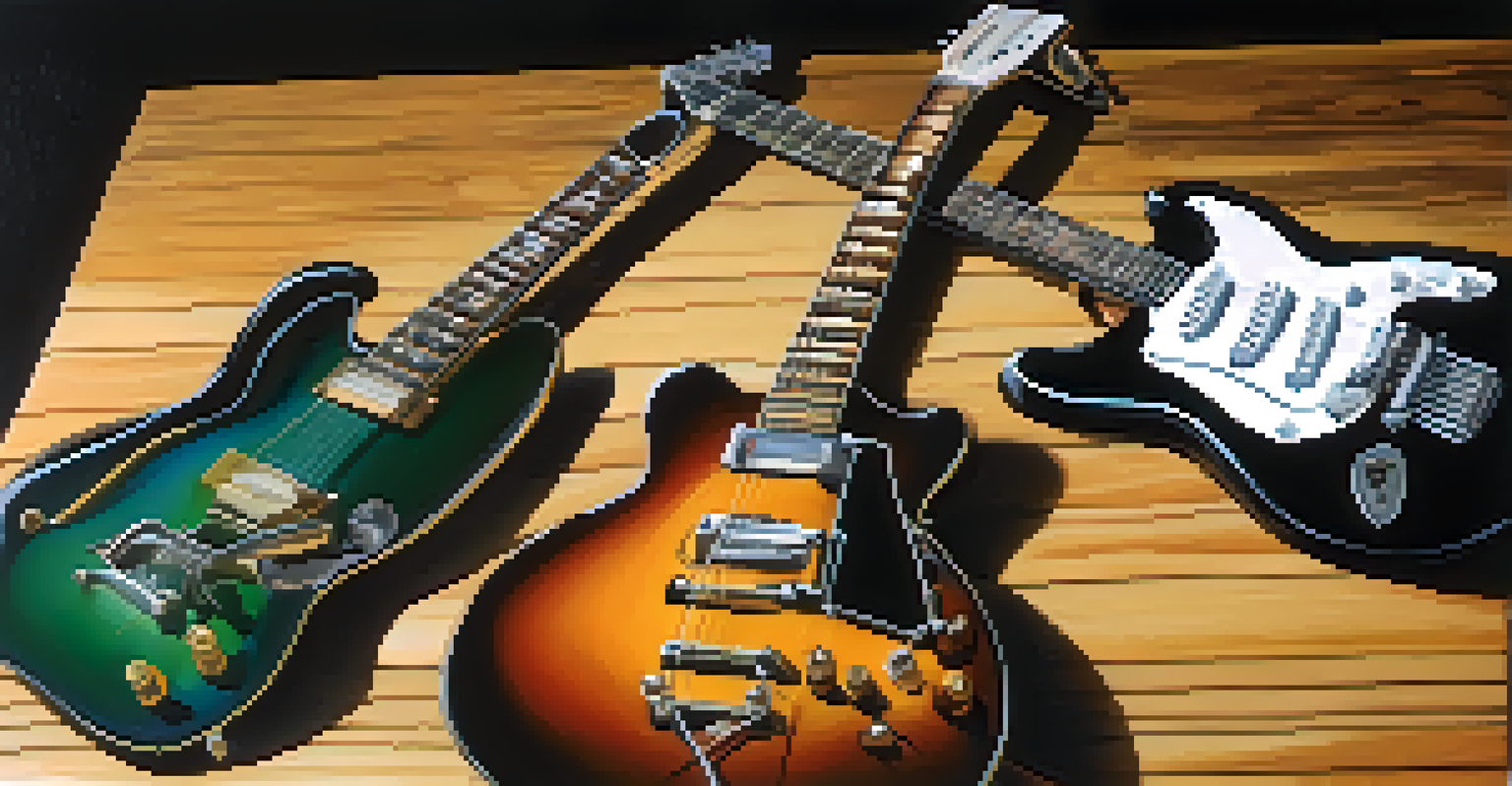Using Slide Guitar Techniques to Create Expressive Sounds

Understanding the Basics of Slide Guitar Technique
Slide guitar is a unique playing style that uses a slide, typically made of glass or metal, to glide over the strings. This technique allows for smooth transitions between notes, creating a vocal quality that can be incredibly expressive. Unlike traditional fingerpicking or strumming, the slide gives you the freedom to bend pitches and create a more fluid sound.
The slide guitar is a voice in itself, a way of expressing feelings and emotions that words cannot convey.
To start, you'll want to choose a slide that fits comfortably on your finger; this is crucial for ease of movement. Beginners often opt for a glass slide, as it offers a warm tone, but experimenting with different materials can yield various sounds. Remember, the slide should touch the strings lightly to avoid muting them while still producing a clear note.
Practicing with a slide might feel awkward at first, but with time, you'll develop a technique that enhances your playing style. Focus on the placement of the slide relative to the fretboard, as this will determine the pitch and tonal quality of the notes you produce. Soon enough, you'll be able to incorporate this technique into your music seamlessly.
Choosing the Right Slide for Your Sound
The type of slide you choose can dramatically affect your sound, so it's essential to consider your musical style. Glass slides are popular for their warm, rich tones, while metal slides can produce a sharper, brighter sound. Ceramic slides offer a unique middle ground, providing a warmer tone than metal but with a bit more brightness than glass.

Experimenting with different slides can help you discover what resonates with your personal style. For instance, if you play blues, a heavier metal slide might give you that gritty, raw sound, while a lighter glass slide can add a smoother feel for country or folk music. Don’t hesitate to try various materials to find the perfect match for your musical expression.
Choose the Right Slide Material
Selecting a slide made of glass, metal, or ceramic can significantly influence your sound and playing style.
Ultimately, your choice of slide should feel comfortable and natural in your hand. Remember, the right slide can enhance your ability to create expressive sounds, so take your time to explore the options available. You might be surprised at how a simple change can open up new creative avenues in your playing.
Mastering Basic Slide Techniques
Once you have your slide and are comfortable with it, it’s time to practice basic techniques. Start with simple slides, where you glide the slide from one note to another without lifting it off the strings. This technique creates a seamless sound that is characteristic of slide guitar and can be used in various genres.
Music is the shorthand of emotion.
Additionally, try incorporating vibrato by gently rocking the slide back and forth on a note. This adds a touch of expressiveness that can elevate your performance significantly. Practicing vibrato will help you develop control and add emotional depth to your playing.
Don't forget to explore different finger placements as well. Placing the slide directly over the fret will give you a clear note, while positioning it slightly behind can create a more muted sound. Experimenting with these variations will help you develop a unique sound that reflects your musical personality.
Incorporating Bends and Drones for Emotion
Bending notes is a fundamental aspect of slide guitar that adds emotional depth to your playing. By applying pressure to the slide while moving it up or down the fretboard, you can create a pitch bend that mimics the human voice. This technique is especially powerful in blues and rock music, where emotion is a key component.
In addition to bends, consider using drone notes—sustaining one note while playing others can create a rich texture in your music. This technique allows the listener to focus on the melody while still feeling the underlying harmony, much like a singer holding a note while accompanied by instruments.
Practice Techniques Regularly
Consistent practice helps build muscle memory and enhances your ability to express yourself through slide guitar.
Combining bends and drone notes can lead to some truly expressive sounds. For example, while holding a drone on the low E string, you might bend a note on the G string to create a contrast that captures attention. This interplay between tension and release can evoke strong emotions and engage your audience.
Adding Harmonics for Unique Textures
Harmonics can add an ethereal quality to your slide guitar playing, and they are relatively easy to incorporate. Simply lightly touch the string above the fret while using the slide to create a harmonic note. This technique produces a bell-like sound that can enhance the overall texture of your music.
You can find harmonics at various points on the fretboard, such as the 5th, 7th, and 12th frets. Each harmonic has its own character, so experiment with different locations to see what resonates with your style. Incorporating these notes at strategic points in your playing can create beautiful contrasts.
Using harmonics alongside traditional slide techniques can open up a world of creativity in your music. For instance, try alternating between regular notes and harmonics for a captivating effect. This juxtaposition will keep your audience engaged and add layers to your sound.
Exploring Different Tunings for Creativity
One of the most exciting aspects of slide guitar is the ability to explore alternate tunings. Open tunings, such as open G or open D, allow for unique chord voicings that can inspire new musical ideas. These tunings often make it easier to achieve that signature slide sound, as the strings are arranged to facilitate playing with a slide.
For example, in open G tuning, you can easily play a major chord by strumming all the strings while using the slide, giving you a fuller sound. This can be particularly effective in genres like blues and folk, where rich, resonant chords are essential. Don't hesitate to tune your guitar in ways that suit your musical preferences.
Explore Alternate Tunings
Using open tunings can inspire new musical ideas and facilitate achieving that signature slide sound.
As you experiment with different tunings, you'll likely discover new melodies and riffs that inspire you. Each tuning can unlock a different emotional response, giving you the freedom to express yourself in ways you may not have thought possible. Embrace the adventure of tuning experimentation—it could lead to your next creative breakthrough.
Practicing Slide Guitar Techniques Regularly
Consistency is key when mastering slide guitar techniques. Regular practice not only helps you build muscle memory but also allows you to explore and refine your sound over time. Setting aside dedicated practice sessions can lead to noticeable improvements in your skills and comfort level with the slide.
Consider incorporating a variety of exercises into your practice routine. Focus on scales, chords, and improvisation, all while using the slide. This will help you become more versatile and comfortable with different musical styles, ultimately enhancing your expressiveness as a guitarist.

Remember, the journey of mastering slide guitar is a personal one. Celebrate small victories along the way, and don’t shy away from experimenting. The more you practice, the more your unique voice will emerge, allowing you to create the expressive sounds that resonate with you and your audience.